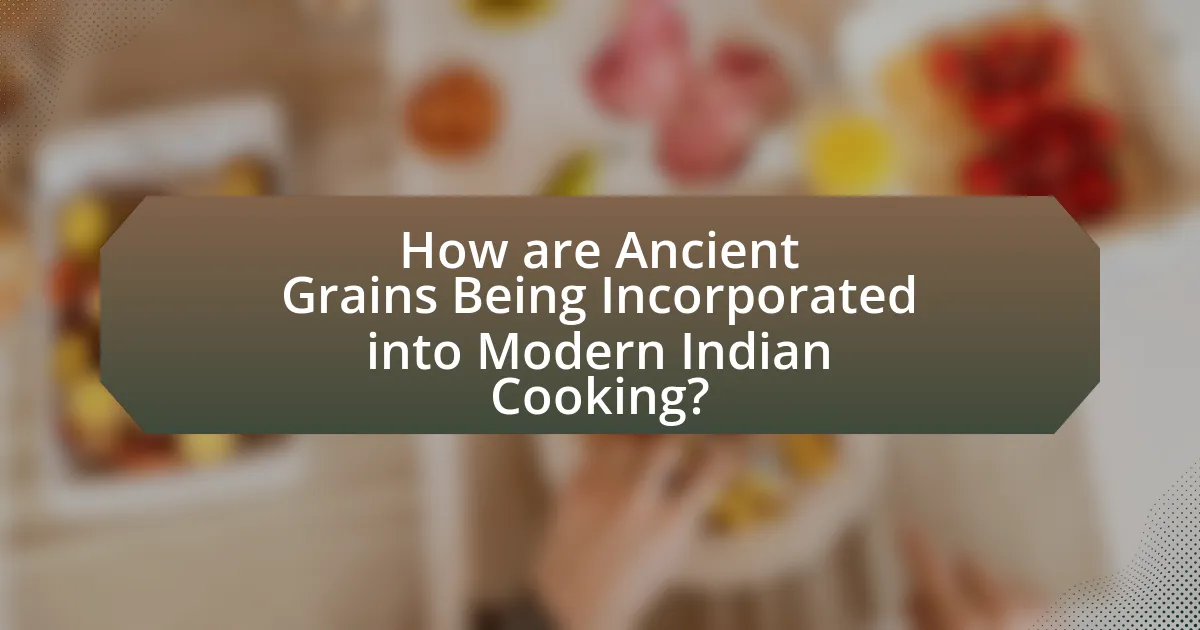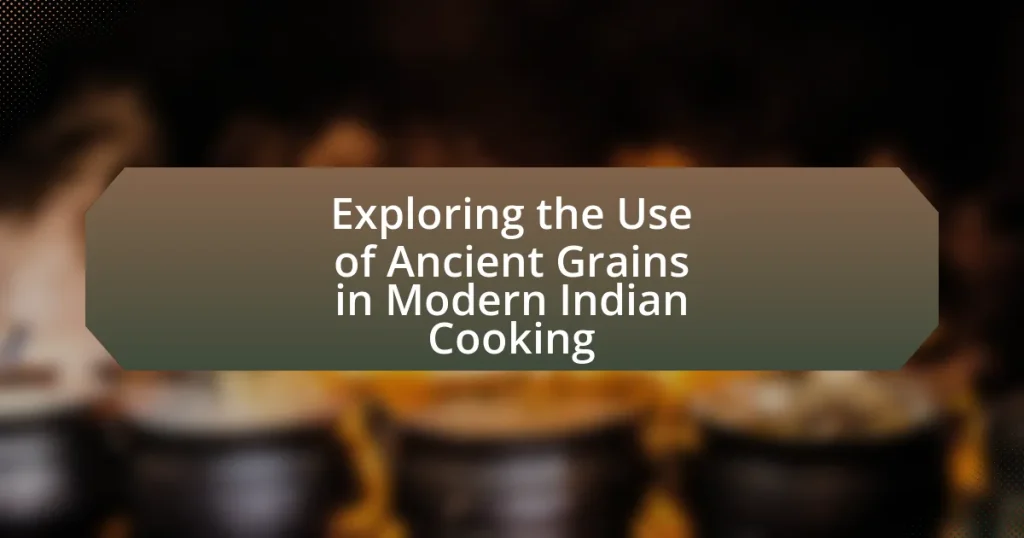Ancient grains, such as quinoa, millet, barley, and amaranth, have remained largely unchanged over centuries and hold significant nutritional value, making them a vital component of Indian cooking. This article explores the differences between ancient and modern grains, highlighting their superior nutritional profiles, health benefits, and sustainability. It examines the role of ancient grains in traditional Indian cuisine, their incorporation into modern recipes, and the challenges faced when using them. Additionally, it provides practical tips for beginners on cooking and meal planning with ancient grains, emphasizing their relevance in promoting healthier eating habits in contemporary India.

What are Ancient Grains and Their Significance in Indian Cooking?
Ancient grains are cereal grains that have remained largely unchanged over the last several hundred years, including varieties such as quinoa, millet, barley, and amaranth. Their significance in Indian cooking lies in their nutritional value, as they are rich in protein, fiber, vitamins, and minerals, making them a healthier alternative to refined grains. Historically, these grains have been integral to traditional Indian diets, providing sustenance and energy, particularly in rural areas. Additionally, ancient grains are often gluten-free, catering to dietary restrictions and preferences, which enhances their relevance in contemporary Indian cuisine.
How do ancient grains differ from modern grains?
Ancient grains differ from modern grains primarily in their genetic diversity and nutritional profiles. Ancient grains, such as quinoa, farro, and spelt, have remained largely unchanged over thousands of years, retaining their original characteristics and often containing higher levels of protein, fiber, and essential nutrients compared to modern grains like wheat and corn, which have been selectively bred for higher yields and specific traits. For instance, a study published in the Journal of Agricultural and Food Chemistry found that ancient grains often have a lower glycemic index, making them more beneficial for blood sugar control. This genetic stability in ancient grains contributes to their resilience and adaptability in various growing conditions, contrasting with the more uniform and less diverse modern grains.
What are the nutritional benefits of ancient grains?
Ancient grains offer numerous nutritional benefits, including high fiber content, essential amino acids, vitamins, and minerals. These grains, such as quinoa, farro, and millet, are rich in dietary fiber, which aids digestion and promotes satiety. They also provide complete proteins, containing all nine essential amino acids, making them an excellent choice for vegetarians and vegans. Furthermore, ancient grains are often high in B vitamins, iron, magnesium, and antioxidants, contributing to overall health and reducing the risk of chronic diseases. For example, quinoa contains about 8 grams of protein and 5 grams of fiber per cooked cup, highlighting its nutritional density.
Why are ancient grains considered sustainable?
Ancient grains are considered sustainable because they typically require fewer resources to grow and are more resilient to climate change compared to modern grains. For instance, varieties like quinoa and millet are drought-resistant and can thrive in poor soil conditions, reducing the need for chemical fertilizers and extensive irrigation. Additionally, ancient grains often have a lower carbon footprint due to their adaptability and the traditional farming practices associated with them, which emphasize biodiversity and soil health. Studies have shown that these grains can contribute to sustainable agricultural systems by promoting crop rotation and reducing dependency on monocultures, thereby enhancing ecosystem resilience.
What role do ancient grains play in traditional Indian cuisine?
Ancient grains play a significant role in traditional Indian cuisine by serving as staple foods that contribute to nutritional diversity and cultural heritage. Grains such as millet, barley, and quinoa have been cultivated in India for thousands of years, providing essential nutrients and forming the basis of various regional dishes. For instance, millet is commonly used in the preparation of rotis and porridge, while barley is often incorporated into soups and salads. These grains are not only valued for their health benefits, including high fiber content and low glycemic index, but they also reflect the agricultural practices and culinary traditions of different Indian communities. The resurgence of interest in ancient grains in modern cooking highlights their importance in promoting sustainable diets and preserving traditional food practices.
Which ancient grains are commonly used in Indian cooking?
Ancient grains commonly used in Indian cooking include millet, quinoa, and barley. Millet, particularly varieties like finger millet (ragi) and pearl millet (bajra), has been a staple in various regions of India for centuries, known for its nutritional benefits and adaptability to local climates. Quinoa, while not traditionally Indian, has gained popularity due to its high protein content and is often incorporated into modern Indian dishes. Barley, used in various forms such as flour or whole grains, has historical significance in Indian diets, especially in northern regions. These grains are valued for their health benefits, including high fiber content and essential nutrients, making them integral to both traditional and contemporary Indian cuisine.
How have ancient grains influenced regional Indian dishes?
Ancient grains have significantly influenced regional Indian dishes by introducing diverse flavors, textures, and nutritional benefits. For instance, grains like millet, barley, and quinoa have been incorporated into traditional recipes, enhancing the culinary landscape across various states. In Rajasthan, bajra (pearl millet) is a staple, used in dishes like bajra khichdi and bajra roti, which are rich in fiber and essential nutrients. Similarly, in South India, ragi (finger millet) is utilized in making ragi mudde, a nutritious alternative to rice. The resurgence of these grains in modern cooking reflects a growing awareness of their health benefits, as they are often gluten-free and high in protein. This integration not only preserves traditional practices but also promotes sustainable agriculture by encouraging the cultivation of indigenous crops.

How are Ancient Grains Being Incorporated into Modern Indian Cooking?
Ancient grains are being incorporated into modern Indian cooking through the use of ingredients like quinoa, millet, and amaranth in traditional recipes. These grains are often used as substitutes for rice and wheat, enhancing nutritional value while maintaining cultural flavors. For example, quinoa is increasingly used in pulao and salads, while millet is featured in rotis and porridge, reflecting a shift towards healthier eating habits. This trend is supported by research from the Indian Journal of Traditional Knowledge, which highlights the health benefits of ancient grains, including higher protein and fiber content compared to conventional grains.
What are some popular modern recipes using ancient grains?
Popular modern recipes using ancient grains include quinoa salad, farro risotto, and millet porridge. Quinoa salad combines cooked quinoa with fresh vegetables and a light dressing, providing a nutritious and protein-rich meal. Farro risotto utilizes farro, an ancient wheat grain, cooked slowly with broth and finished with cheese, creating a creamy texture. Millet porridge is made by simmering millet with water or milk, often sweetened with fruits or spices, offering a wholesome breakfast option. These recipes highlight the versatility and health benefits of ancient grains in contemporary cooking.
How can ancient grains be used in everyday meals?
Ancient grains can be incorporated into everyday meals by using them as substitutes for conventional grains in various dishes. For instance, quinoa can replace rice in pilafs, while millet can be used in porridge or as a side dish. These grains are not only nutritious, providing essential amino acids, fiber, and minerals, but they also offer unique flavors and textures that enhance traditional recipes. Studies show that incorporating ancient grains into diets can improve overall health, as they are linked to lower risks of chronic diseases due to their high antioxidant content and low glycemic index.
What innovative cooking techniques enhance ancient grains in modern recipes?
Innovative cooking techniques that enhance ancient grains in modern recipes include fermentation, pressure cooking, and incorporating them into diverse culinary applications like salads and baked goods. Fermentation, for instance, not only improves the digestibility of grains like quinoa and millet but also enhances their nutritional profile by increasing bioavailability of nutrients. Pressure cooking significantly reduces cooking time while preserving the grains’ texture and flavor, making them more appealing in contemporary dishes. Additionally, using ancient grains in salads or as flour substitutes in baking introduces unique flavors and textures, aligning with current health trends that favor whole, nutrient-dense foods. These techniques reflect a growing interest in integrating ancient grains into modern diets, supported by research indicating their health benefits, such as improved heart health and reduced risk of chronic diseases.
Why is there a resurgence of ancient grains in contemporary Indian diets?
The resurgence of ancient grains in contemporary Indian diets is primarily driven by a growing awareness of their nutritional benefits and health advantages. Ancient grains such as millet, quinoa, and amaranth are rich in protein, fiber, vitamins, and minerals, making them healthier alternatives to refined grains. Research indicates that these grains have lower glycemic indices, which can help in managing blood sugar levels, thus appealing to health-conscious consumers. Additionally, the increasing interest in sustainable and organic farming practices has led to a revival of these grains, as they often require less water and are more resilient to climate change compared to conventional crops. This combination of health benefits and environmental sustainability is fueling their popularity in modern Indian cooking.
What health trends are driving the popularity of ancient grains?
The health trends driving the popularity of ancient grains include the increasing consumer demand for gluten-free options, higher awareness of nutritional benefits, and a shift towards plant-based diets. Ancient grains such as quinoa, farro, and amaranth are recognized for their high protein content, essential amino acids, and rich fiber, which contribute to better digestive health and weight management. Research indicates that these grains often contain more vitamins and minerals compared to refined grains, making them a preferred choice for health-conscious individuals. Additionally, the rise in chronic health issues, such as obesity and diabetes, has led consumers to seek out whole foods that offer better health outcomes, further boosting the appeal of ancient grains in modern cooking.
How do ancient grains fit into the concept of healthy eating in India?
Ancient grains fit into the concept of healthy eating in India by providing nutrient-dense alternatives to refined grains, which are prevalent in many diets. These grains, such as quinoa, millet, and amaranth, are rich in protein, fiber, vitamins, and minerals, contributing to overall health and wellness. For instance, millet is known to have a low glycemic index, making it beneficial for blood sugar control, while quinoa contains all nine essential amino acids, making it a complete protein source. The incorporation of these grains into traditional Indian recipes not only enhances nutritional value but also aligns with the growing trend of health-conscious eating in the country.

What Challenges and Considerations Exist When Using Ancient Grains?
Using ancient grains presents challenges such as limited availability, higher costs, and potential allergenic properties. Limited availability arises because ancient grains are often grown in specific regions and may not be widely cultivated, leading to supply issues. Higher costs are associated with the cultivation and harvesting of these grains, as they are typically produced on a smaller scale compared to conventional grains. Additionally, some ancient grains, like quinoa and amaranth, can trigger allergic reactions in sensitive individuals, necessitating careful consideration for those with food allergies. These factors must be addressed to effectively incorporate ancient grains into modern Indian cooking.
What are the common misconceptions about ancient grains?
Common misconceptions about ancient grains include the belief that they are gluten-free, that they are always healthier than modern grains, and that they are difficult to cook. Many ancient grains, such as spelt and barley, contain gluten, which can be problematic for those with gluten sensitivities. Additionally, while ancient grains often have higher nutritional profiles than some modern grains, this is not universally true; for example, some ancient grains may have similar or lower nutrient levels compared to modern varieties. Lastly, ancient grains can be prepared using standard cooking methods, and many are readily available in pre-cooked or easy-to-use forms, making them accessible for modern cooking.
How can one overcome the challenges of cooking with ancient grains?
To overcome the challenges of cooking with ancient grains, one should first understand their unique cooking requirements, such as longer soaking and cooking times compared to conventional grains. For instance, grains like quinoa and farro often require soaking for several hours to improve texture and reduce cooking time. Additionally, using appropriate water-to-grain ratios is crucial; for example, quinoa typically needs a 2:1 water ratio.
Moreover, incorporating ancient grains into familiar recipes can ease the transition, allowing cooks to blend them with traditional ingredients. Research indicates that ancient grains are rich in nutrients, which can enhance the overall health profile of meals. By gradually experimenting with these grains in various dishes, one can effectively adapt to their distinct flavors and textures, making the cooking process more manageable and enjoyable.
What are the storage and preparation tips for ancient grains?
Ancient grains should be stored in a cool, dry place in airtight containers to maintain freshness and prevent moisture absorption. For preparation, it is essential to rinse the grains thoroughly before cooking to remove any impurities and enhance digestibility. Cooking times vary by grain; for example, quinoa typically takes about 15 minutes to cook, while farro may require up to 30 minutes. Soaking grains like millet or barley for several hours can reduce cooking time and improve texture. These practices ensure optimal flavor and nutritional benefits, as supported by studies indicating that proper storage and preparation enhance the bioavailability of nutrients in grains.
How can one effectively incorporate ancient grains into a modern Indian diet?
One can effectively incorporate ancient grains into a modern Indian diet by substituting them for conventional grains in traditional recipes. For instance, using quinoa or amaranth in place of rice or wheat flour in dishes like khichdi or rotis enhances nutritional value while maintaining cultural relevance. Ancient grains such as millet and barley are rich in fiber, protein, and essential nutrients, making them beneficial for health. Research indicates that these grains can help manage diabetes and improve gut health, as evidenced by a study published in the Journal of Nutrition, which highlights their low glycemic index and high antioxidant content. By integrating these grains into everyday meals, individuals can enjoy both the health benefits and the flavors of traditional Indian cuisine.
What are some practical tips for beginners using ancient grains?
Beginner cooks should start by incorporating ancient grains like quinoa, farro, and millet into their meals gradually. These grains can be used as substitutes for rice or pasta, providing a nutritious alternative rich in fiber and protein. To prepare them, rinse the grains thoroughly before cooking to remove any bitterness, and follow package instructions for cooking times and water ratios, as they can vary significantly. For example, quinoa typically requires a 2:1 water-to-grain ratio and cooks in about 15 minutes. Additionally, mixing ancient grains with familiar ingredients, such as vegetables and spices, can enhance flavor and ease the transition into using these grains. This approach not only diversifies the diet but also introduces beneficial nutrients, as ancient grains are often higher in vitamins and minerals compared to refined grains.
How can meal planning help in utilizing ancient grains effectively?
Meal planning can help in utilizing ancient grains effectively by ensuring their inclusion in a balanced diet and promoting variety in meals. By strategically planning meals, individuals can incorporate grains like quinoa, millet, and amaranth, which are rich in nutrients and have been consumed for thousands of years. Research indicates that ancient grains are high in fiber, protein, and essential vitamins, making them beneficial for health. For instance, a study published in the Journal of Nutrition found that diets including whole grains can reduce the risk of chronic diseases. Therefore, meal planning not only facilitates the regular consumption of these grains but also enhances overall dietary quality.
What are the best practices for cooking with ancient grains?
The best practices for cooking with ancient grains include rinsing them thoroughly before cooking, soaking them for several hours to enhance digestibility, and using a proper water-to-grain ratio to ensure even cooking. Rinsing removes surface starch and impurities, while soaking can reduce cooking time and improve nutrient absorption. For example, quinoa typically requires a 2:1 water-to-grain ratio, while farro may need 3:1, depending on the desired texture. These methods not only optimize flavor and texture but also align with traditional practices that have been used for centuries in various cultures.
